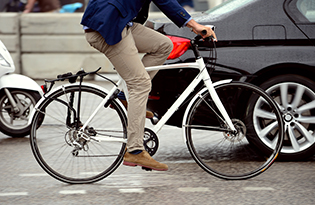Motorcycle and bicycle awareness: Creating safer roads
5/8/2025 by David Brennan, M.D.

Every year, a significant number of injuries and deaths result from vehicle collisions with bicycles and motorcycles. In the state of Minnesota in 2022, for example, there were six deaths and 499 reported injuries after a bicycle versus motor vehicle accident. That same year, there were 26 fatalities from motorcycle crashes involving another motor vehicle. Almost half of all motorcycle crashes involve a collision with a car or truck. As primary care clinicians, we want to share some tips on how both drivers and riders can take steps to create safer roads for everyone.
For drivers
- Stay alert: Always be on the lookout for motorcycles and bicycles, especially at intersections and during lane changes. Keep in mind that motorcycles and bicycles are vulnerable on the road due to their smaller size and lower visibility compared to cars and trucks.
- Give space: Maintain a safe distance when passing cyclists and motorcyclists. A minimum of three feet is recommended.
- Avoid distractions: Keep your focus on the road and avoid using mobile devices while driving.
- Right-hand turns: Be particularly cautious when making right-hand turns at intersections. Check for cyclists who may be approaching from behind or riding alongside your vehicle. Keep in mind that a bicyclist in a bike lane next to you may intend to go straight. There are conventions and laws for cyclists and drivers depending on the type of intersection, but be alert since not all are aware of the rules.
For bicyclists and motorcyclists
- Wear protective gear: Helmets, reflective clothing and other protective gear can significantly reduce the risk of injury.
- Follow traffic rules: Obey traffic signals and signs, and ride in designated bike lanes whenever possible. When riding in vehicle lanes, always ride in the direction of traffic. Riding on sidewalks is considered dangerous and is sometimes illegal — use extra caution when crossing driveways and intersections as drivers may not be expecting you, especially if you are moving quickly.
- Be visible: Use lights and reflectors, especially during low-light conditions. Bright and reflective clothing can also help. Avoid riding in the dark.
- Avoid high-traffic areas: Plan routes that minimize exposure to heavy traffic. Use bike paths and quieter streets when possible.
- Use hand signals: Indicate turns and stops using hand signals to inform drivers of your actions.
- Use technology: Invest in devices that detect cars approaching from behind, such as rearview radar systems.
For everyone
By fostering a culture of awareness and mutual respect on the roads, we can do our part to reduce injuries and fatalities among cyclists and motorcyclists. Let's work together to ensure that our roads are safe for all users, whether they are on two wheels or four.
David Brennan, M.D., is a primary care physician in the Division of Community Internal Medicine, Geriatrics and Palliative Care in Rochester, Minnesota. He focuses on prevention and treatment of a wide variety of common diseases.
